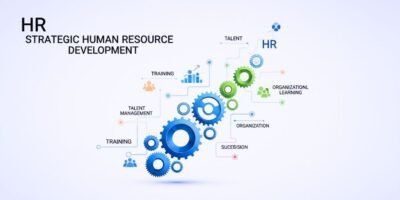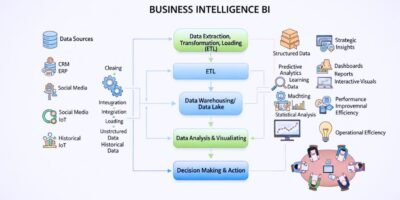Human Resource Planning is a strategic process that involves forecasting an organization’s future human resource needs and developing strategies to meet those needs. It is a proactive approach to ensure that an organization has the right people and skills in the right positions at the right time. This article explores the concept of human resource planning, its significance, key components, challenges, and impact on organizational success.
Understanding Human Resource Planning
Human resource planning is a systematic process that helps organizations align their people strategy with business goals. It involves assessing current human resource capabilities, forecasting future workforce requirements, and developing strategies to acquire, design, and retain the necessary talent.
Human resource planning considers business expansion, technological advancements, changing market dynamics, and workforce demographics. It ensures the organization has a workforce that can meet current and future demands, adapt to changes, and drive organizational success.
Key Components of Human Resource Planning
Human resource planning begins with analyzing the internal and external factors that can impact the organization’s human resource needs. This includes analyzing the organization’s business strategy, industry trends, labor market conditions, and regulatory changes. Understanding these factors helps develop a comprehensive HR plan.
Workforce Demand Forecasting
Forecasting future workforce demand is critical to human resource planning. It involves projecting the number of employees needed, the skills and competencies required, and the timing of resource requirements. Workforce demand forecasting can be based on business growth plans, attrition rates, retirement projections, and technological advancements.
Workforce Supply Analysis
Once the workforce demand is forecasted, organizations must analyze the existing workforce and determine if they have the necessary skills, experience, and capacity to meet future demand. This analysis involves assessing the current workforce demographics, identifying skill gaps, and determining the availability of talent both internally and externally.
Gap Analysis and Action Plans
The gap analysis compares the forecasted demand with the current talent supply to identify the gaps. Based on the research, action plans are developed to address the gaps. These plans may include recruitment strategies, training and development programs, succession planning, and talent acquisition initiatives.
Implementation and Evaluation
Implementing human resource planning involves executing the strategies and initiatives identified in the action plans. Regularly monitoring and evaluating the resource planning process helps assess the system’s effectiveness, make necessary adjustments, and ensure continuous alignment with organizational goals.
Significance of Human Resource Planning
Human resource planning is crucial for organizations due to the following reasons:
Talent Acquisition and Retention
Human resource planning ensures organizations have the right talent to achieve their goals. It helps attract, recruit, and retain skilled employees by identifying their needs, offering competitive compensation and benefits, and providing opportunities for growth and development.
Cost Efficiency
Effective human resource planning helps organizations optimize their workforce and avoid unnecessary costs. By accurately forecasting workforce demand, organizations can avoid overstaffing or understaffing situations, reduce recruitment and training costs, and improve productivity.
Succession Planning
Human resource planning facilitates succession planning by identifying critical positions and developing talent pools to fill key roles. It ensures a smooth transition when employees retire, resign, or are promoted, minimizing disruptions to the organization’s operations.
Change Management
In a dynamic business environment, organizations must adapt to technological advancements, market fluctuations, and regulatory changes. Human resource planning helps organizations identify the skills and competencies required to embrace change, develop training programs to upskill employees, and manage transitions effectively.
Strategic Alignment
Human resource planning aligns the organization’s people and business strategies. It ensures the organization has the right talent and skills to achieve its strategic objectives. It also helps identify gaps and areas for improvement, enabling the HR department to contribute to the strategic decision-making process.
Challenges in Human Resource Planning
Implementing effective human resource planning can be challenging due to various factors:
Uncertain Future
Forecasting future workforce needs can be challenging due to uncertainties such as economic conditions, industry disruptions, and technological advancements. Organizations must develop flexible strategies to adapt to changing circumstances.
Data Availability and Accuracy
It relies on accurate data about the current workforce, skill sets, and future projections. Limited data availability or precise data can help the planning process. Organizations need to invest in robust data management systems and ensure data integrity.
Rapid Technological Advancements
Technological advancements can quickly render certain skills obsolete and create a demand for new skills. HR departments must stay updated on technological trends and identify skill gaps to address the organization’s changing needs.
Resistance to Change
Employees and management may resist implementing changes identified through the planning process. Effective change management strategies, communication, and stakeholder engagement are essential to overcome resistance and ensure successful implementation.
External Factors
External factors such as labor market conditions, government regulations, and demographic shifts can impact workforce availability and talent acquisition efforts. Organizations must consider these external factors when developing HR plans.
Impact of Human Resource Planning
Human resource planning has a significant impact on organizational success:
Improved Organizational Performance
It ensures that organizations have the right talent with the necessary skills to achieve their goals. It leads to improved productivity, efficiency, and overall organizational performance.
Talent Development and Engagement
It identifies employees’ development needs, which helps design appropriate training and development programs. These initiatives enhance employee skills, engagement, and job satisfaction, increasing retention rates.
Effective Resource Allocation
Human resource planning helps organizations allocate resources efficiently by identifying areas where additional resources are needed and where resources can be optimized. It leads to cost savings and better resource utilization.
Risk Mitigation
By identifying skill gaps and succession needs, HR planning helps mitigate risks associated with talent shortages, turnover, and leadership transitions. It ensures business continuity and minimizes disruptions to operations.
Strategic Decision-Making
Human resource planning provides valuable insights into the organization’s workforce capabilities, strengths, and weaknesses. This information enables HR professionals and organizational leaders to make informed decisions and develop effective strategies for achieving long-term goals.
Conclusion
Human resource planning is a strategic process that ensures organizations have the right people with the right skills, positions, and time. It aligns the organization’s people strategy with its overall business goals, leading to improved organizational performance, talent development, and effective resource allocation. Despite challenges such as uncertain future conditions and resistance to change, organizations prioritizing human resource planning are better equipped to navigate the dynamic business landscape, attract and retain top talent, and drive sustainable growth and success.













